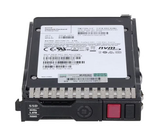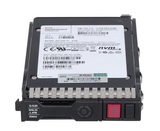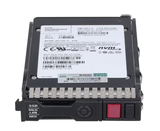HPE Mixed Use Gen 10+ SSD: Powering Modern Data Centers and Enterprise Applications
In today’s fast-paced digital landscape, the demand for faster, more reliable data storage solutions is greater than ever. Hewlett Packard Enterprise (HPE) has been at the forefront of delivering innovative hardware, and their HPE Mixed Use Gen 10+ SSDs are no exception. These high-performance solid-state drives (SSDs) are designed to meet the diverse needs of modern data centers, enterprise workloads, and cloud-based applications, offering a blend of speed, endurance, and efficiency. This article explores the features, benefits, and ideal use cases of HPE Mixed Use Gen 10+ SSDs.
What is the HPE Mixed Use Gen 10+ SSD?
HPE Mixed Use Gen 10+ SSDs are a part of HPE’s broader storage portfolio, providing businesses with the performance they need to handle a variety of workloads. These drives are designed to balance read and write operations, making them suitable for mixed-use environments—where both types of operations occur in tandem, such as in databases, virtualization, and cloud services.
The Gen 10+ in the name refers to the third generation of HPE’s NVMe-based SSDs, which bring substantial improvements over previous models in terms of speed, endurance, and overall performance. These drives are available in multiple form factors and capacities, offering a wide range of options to meet different performance and storage needs.
Key Features of HPE Mixed Use Gen 10+ SSDs
1. Performance with NVMe Interface
One of the standout features of the HPE Mixed Use Gen 10+ SSDs is their use of the NVMe (Non-Volatile Memory Express) interface. NVMe drives provide dramatically higher data transfer speeds compared to traditional SATA SSDs, reducing bottlenecks and ensuring faster data access, which is crucial for real-time applications. With NVMe, these SSDs offer low latency, high throughput, and parallel data access, enhancing the performance of mission-critical workloads such as databases and cloud environments.
2. Enhanced Endurance for Mixed Workloads
The Mixed Use designation indicates that these SSDs are engineered to handle a combination of read and write operations, which is typical in environments like enterprise IT infrastructure and virtualized systems. The Gen 10+ SSDs are built with a high TBW (Total Bytes Written) rating, meaning they can endure substantial write-intensive workloads without significant degradation in performance over time. This makes them a solid choice for applications that demand both high-speed reads and writes, such as online transaction processing (OLTP), file servers, and web servers.
3. Compatibility with HPE ProLiant Servers
HPE’s Mixed Use Gen 10+ SSDs are optimized for use with HPE ProLiant Gen10 servers, which are commonly used in data centers for running high-performance applications. This compatibility ensures that businesses can easily integrate these drives into their existing infrastructure without worrying about compatibility issues, and the drives are fine-tuned to perform optimally within the HPE ecosystem.
4. Scalable Capacity Options
HPE offers a variety of capacity options for their Gen 10+ SSDs, ranging from smaller capacities (like 240GB or 480GB) to larger options (up to 3.2TB or more). This scalability allows businesses to choose the right storage solution based on the size and performance demands of their applications. With high-capacity SSDs, enterprises can store large datasets and perform intensive computations without compromising on speed.
5. Reliability and Data Integrity
HPE’s Mixed Use Gen 10+ SSDs are built for enterprise-grade reliability. These drives incorporate advanced error-correcting technologies, such as End-to-End Data Protection and Power Loss Protection, which prevent data loss in the event of sudden power failures. Additionally, the wear leveling feature in these SSDs ensures that the storage cells are used evenly, preventing excessive wear on any one area and prolonging the life of the drive.
Benefits of HPE Mixed Use Gen 10+ SSDs
1. Improved Data Throughput
With the NVMe interface and advanced internal architecture, the HPE Mixed Use Gen 10+ SSDs offer impressive read/write speeds. This allows applications to access data more quickly, resulting in reduced load times, faster transactions, and more responsive environments, which is crucial for businesses that rely on high-speed data processing and real-time analytics.
2. Reduced Latency
These SSDs help minimize latency by using high-speed, low-latency memory technologies. Whether you're handling transaction processing or running virtualized environments, the reduced access times can significantly enhance user experiences and overall system responsiveness.
3. Optimized Power Consumption
HPE SSDs are designed with power efficiency in mind. While providing high performance, they ensure that power consumption is minimized, which is especially important in large data centers where energy costs are a significant factor. By optimizing power usage, HPE helps organizations reduce operational costs while maintaining peak performance.
4. Future-Proof Solution
As businesses grow and their data processing needs evolve, scalability becomes an essential factor. The HPE Mixed Use Gen 10+ SSDs are designed to meet the future needs of businesses, offering high IOPS (Input/Output Operations Per Second) and throughput to support workloads well into the future. This makes them a great investment for organizations looking for storage solutions that can scale as their needs increase.
Use Cases for HPE Mixed Use Gen 10+ SSDs
1. Virtualization
In virtualized environments, such as those running VMware or Hyper-V, the storage system plays a critical role in performance. HPE Mixed Use Gen 10+ SSDs provide the speed and reliability necessary to handle the random read/write operations that occur when virtual machines (VMs) are booted, loaded, or used in parallel. The fast access speeds reduce latency and improve VM performance, making them ideal for virtualized infrastructure.
2. Database Management
Modern databases, including SQL and NoSQL databases, rely heavily on high-speed storage for data retrieval and data writing. The HPE Mixed Use Gen 10+ SSDs support these operations efficiently, allowing for faster database queries and high-speed data ingestion. The robust endurance of these SSDs ensures that even write-heavy databases can maintain optimal performance over time.
3. Cloud Environments
With more businesses migrating to the cloud, having fast and reliable storage becomes paramount. The HPE Mixed Use Gen 10+ SSDs offer the low latency and high throughput required to manage cloud-based applications, including cloud storage, data replication, and disaster recovery. Their scalability makes them a good fit for rapidly growing cloud workloads that need to scale with demand.
4. Big Data and Analytics
Processing large volumes of data in real-time is a core requirement for modern analytics workloads. The HPE Mixed Use Gen 10+ SSDs excel in environments that demand high-speed data processing, such as big data analytics, where insights are derived from vast amounts of data. These SSDs enable faster access to critical datasets, reducing the time it takes to process and analyze information.
Conclusion
HPE Mixed Use Gen 10+ SSDs provide a compelling storage solution for businesses requiring high performance, reliability, and scalability. These drives, optimized for enterprise environments, cloud computing, and big data analytics, deliver superior speed and low latency, significantly enhancing the performance of modern IT infrastructure. Whether you are running a high-performance database, a virtualized environment, or a cloud-based application, the HPE Mixed Use Gen 10+ SSDs offer the reliability and endurance needed to meet the demands of today’s fast-paced digital world.
Incorporating these SSDs into your infrastructure can drive business success by improving operational efficiency, reducing downtime, and ensuring that data remains secure and accessible at all times.
Recent Posts
-
Turbocharging Data Centers: Unleashing the HPE 1.6TB NVMe PCIe SSD for ProLiant Gen9 & Gen10
HPE 1.6TB 2.5inch Small Form Factor NVMe PCIe Light Endurance SCN Mixed Use Solid State Drive for Pr …Apr 18th 2025 -
HPE 1.6TB NVMe U.3 PCIe SSD: Unleashing Turbo-Charged Performance for ProLiant Gen10 Powerhouses
HPE 1.6TB 2.5-inch Small Form Factor Digitally Signed Firmware NVMe U.3 PCIe High Performance SCN Mi …Apr 17th 2025 -
HPE 1.6TB NVMe U.3 PCIe SSD: Powering ProLiant Gen10 Plus Servers with High Performance and Security
HPE 1.6TB 2.5-Inch SFF NVMe U.3 PCIe Mixed Use SSD for ProLiant Gen10 Plus Servers Introduction …Apr 16th 2025




